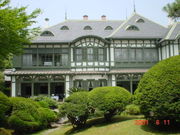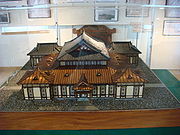
Tatsuno Kingo
Encyclopedia

Japan
Japan is an island nation in East Asia. Located in the Pacific Ocean, it lies to the east of the Sea of Japan, China, North Korea, South Korea and Russia, stretching from the Sea of Okhotsk in the north to the East China Sea and Taiwan in the south...
ese architect
Architect
An architect is a person trained in the planning, design and oversight of the construction of buildings. To practice architecture means to offer or render services in connection with the design and construction of a building, or group of buildings and the space within the site surrounding the...
born in Karatsu
Karatsu, Saga
is a city located in Saga Prefecture on the island of Kyūshū, Japan. Its name, formed from the Japanese word roots 唐 kara , and 津 tsu , signifies its historical importance as an ancient trading port between Japan with China and Korea...
, Saga Prefecture
Saga Prefecture
is located in the northwest part of the island of Kyūshū, Japan. It touches both the Sea of Japan and the Ariake Sea. The western part of the prefecture is a region famous for producing ceramics and porcelain, particularly the towns of Karatsu, Imari, and Arita...
, Kyushu.
He studied in Japan at the Imperial College of Engineering
Imperial College of Engineering
The Imperial College of Engineering was founded as a university at Tokyo in 1873, though its predecessor the existed from 1871. The name "Kobu Daigakko" dates from 1877. In modern-day parlance it would have been called an institute of technology....
where he was one of the first to graduate in 1879 under British architect Josiah Conder
Josiah Conder (architect)
Josiah Conder was a British architect who worked as a foreign advisor to the government of Meiji period Japan...
. He visited England and worked in the office of William Burges in 1881-2. He taught at the University of Tokyo
University of Tokyo
, abbreviated as , is a major research university located in Tokyo, Japan. The University has 10 faculties with a total of around 30,000 students, 2,100 of whom are foreign. Its five campuses are in Hongō, Komaba, Kashiwa, Shirokane and Nakano. It is considered to be the most prestigious university...
. He created his own firm in 1903.
Early career
After his graduation in 1879, Tatsuno journeyed to LondonLondon
London is the capital city of :England and the :United Kingdom, the largest metropolitan area in the United Kingdom, and the largest urban zone in the European Union by most measures. Located on the River Thames, London has been a major settlement for two millennia, its history going back to its...
in 1880 to attend London University. During his stay he worked at the office of the Gothic Revivalist
Gothic Revival architecture
The Gothic Revival is an architectural movement that began in the 1740s in England...
William Burges. Unfortunately, Burges died in 1881 during Tatsuno's stay. Before returning to Japan he travelled in France and Italy for a year. During this time he was influenced by the Queen Anne style
Queen Anne Style architecture
The Queen Anne Style in Britain means either the English Baroque architectural style roughly of the reign of Queen Anne , or a revived form that was popular in the last quarter of the 19th century and the early decades of the 20th century...
.
On his return to Tokyo
Tokyo
, ; officially , is one of the 47 prefectures of Japan. Tokyo is the capital of Japan, the center of the Greater Tokyo Area, and the largest metropolitan area of Japan. It is the seat of the Japanese government and the Imperial Palace, and the home of the Japanese Imperial Family...
, he taught first at the Imperial College of Engineering before becoming department head at the Tokyo University.
In 1886, he was one of the founders of the forerunner of the Architectural Institute of Japan
Architectural Institute of Japan
The Architectural Institute of Japan, or AIJ, is a Japanese professional body for architects, building engineers, and researchers in architecture....
, the then called "Building Institute". The organisation was based upon the Royal Institute of British Architects
Royal Institute of British Architects
The Royal Institute of British Architects is a professional body for architects primarily in the United Kingdom, but also internationally.-History:...
and the group met regularly, sponsored lectures and produced Japan's first architectural journal.
Later career

Inigo Jones
Inigo Jones is the first significant British architect of the modern period, and the first to bring Italianate Renaissance architecture to England...
and Christopher Wren
Christopher Wren
Sir Christopher Wren FRS is one of the most highly acclaimed English architects in history.He used to be accorded responsibility for rebuilding 51 churches in the City of London after the Great Fire in 1666, including his masterpiece, St. Paul's Cathedral, on Ludgate Hill, completed in 1710...
, the Shibusawa Mansion (1888) was influenced by Serlio
Sebastiano Serlio
Sebastiano Serlio was an Italian Mannerist architect, who was part of the Italian team building the Palace of Fontainebleau...
, Ruskin
John Ruskin
John Ruskin was the leading English art critic of the Victorian era, also an art patron, draughtsman, watercolourist, a prominent social thinker and philanthropist. He wrote on subjects ranging from geology to architecture, myth to ornithology, literature to education, and botany to political...
and Conder's own Venetian styled works. The site, on one of Tokyo's canalways suited itself to a Venetian character.
His ties with Shibusawa Eiichi brought him the commission to design the Bank of Japan
Bank of Japan
is the central bank of Japan. The Bank is often called for short. It has its headquarters in Chuo, Tokyo.-History:Like most modern Japanese institutions, the Bank of Japan was founded after the Meiji Restoration...
in 1890 (completed in 1896). It was first building of its type to be designed by a native Japanese person. Tatsuno immediately set off to Europe for a year to do research for the project, studying amongst other buildings, the Banque Nationale in Brussels
Brussels
Brussels , officially the Brussels Region or Brussels-Capital Region , is the capital of Belgium and the de facto capital of the European Union...
by Beyaert
Hendrik Beyaert
Hendrik Beyaert or Henri Beyaert was a Belgian architect.He was born in Kortrijk, Belgium on 29 July 1823 and died in Brussels 22 January 1894. He is considered one of the most important Belgian architects of the 19th-century....
and Janssens.
The bank is a three storey building constructed with reinforced brick faced with stone and has limited use of steel for long spans. Its style is inspired by French Neoclassicism
French Rococo and Neoclassicism
18th-century French art was dominated by the Rococo and neoclassical movements. In France, the death of Louis XIV lead to a period of licentious freedom commonly called the Régence. The heir to Louis XIV, his great grandson Louis XV of France, was only 5 years old; for the next seven years France...
. The original building was square in plan with the banking hall situated immediately behind the porticoed
Portico
A portico is a porch leading to the entrance of a building, or extended as a colonnade, with a roof structure over a walkway, supported by columns or enclosed by walls...
main front.
Tatsuno had a strong influence Japanese colonial architecture - especially in Manchukuo
Manchukuo
Manchukuo or Manshū-koku was a puppet state in Manchuria and eastern Inner Mongolia, governed under a form of constitutional monarchy. The region was the historical homeland of the Manchus, who founded the Qing Empire in China...
. Connection with construction firms like Okada Engineering, the Association of Japanese Architects (Nihon Kenchiku Gakkai 日本建築学界) or through the new Journal of Manchurian Architecture (Manshu kenchiku zasshi 満州建築雑誌),helped insure that a particular architectural style—that popularized by Tatsuno, sometimes called the Tatsuno style (辰野式) initially became the standard throughout Japanese Manchuria. This involved a somewhat grand interpretation of the style of historical eclecticism that was popular in contemporary Europe.
In 1903 he set up his own office, the first Japanese architect in the country to do so. He died as a result of the 1918 flu pandemic in 1919.
Notable buildings


- Bankers' Association Assembly Rooms, Sakamoto-cho, Tokyo (1885)
- Shibusawa Mansion, Kabutocho, Tokyo (1888)
- College of Engineering, Tokyo Imperial University, Hongo (1888)
- The headquarters for the Bank of Japan (1896)
- The first school building of Kyushu Institute of TechnologyKyushu Institute of Technologyis one of the 87 national universities in Japan. Located in Fukuoka Prefecture on the island of Kyūshū, it is dedicated to education and research in the fields of science and technology...
(1909) - National Sumo Arena, Kuramae, Tokyo (1909)
- The West Japan Industrial ClubWest Japan Industrial ClubThe West Japan Industrial Club is in Tobata ward, Kitakyushu. It was designed by Tatsuno Kingo and is his only surviving private house...
, Tobata, Kitakyushu (1911) - Manseibashi StationManseibashi Stationcan refer to two closed train stations all in Chiyoda, Tokyo, Japan. One was a railway station on the Japanese Government Railways Chūō Main Line and the other was a subway station in the Tokyo Subway network....
(1912) - Tōkyō StationTokyo Stationis a train station located in the Marunouchi business district of Chiyoda, Tokyo, Japan, near the Imperial Palace grounds and the Ginza commercial district....
(1914)
External links
- Tatsuno, Kingo | Portraits of Modern Japanese Historical Figures (National Diet LibraryNational Diet LibraryThe is the only national library in Japan. It was established in 1948 for the purpose of assisting members of the in researching matters of public policy. The library is similar in purpose and scope to the U.S...
)

